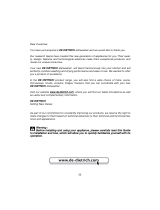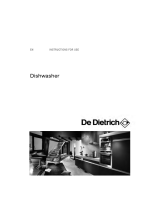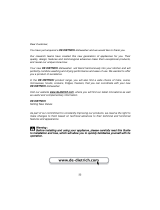
21
e n g l i s h
SUPER EASY: hold the basket by the side handles
and pull upwards with both hands at the same time
(both to raise and lower it)(3.1.2). Ensure that it is
level.
NORMAL: with the basket empty, remove the stops
(3.1.3); take the basket out (3.1.4); insert it at the
required height and t the stop back into place.
3.2 Putting the dishes into the machine.
Ensure that the dishes are dishwasher-safe.
It is not advisable to put items made of wood, silver,
aluminium, decorated porcelain or non
heat-resistant plastic into the dishwasher.
For correct washing, it is essential that the dishes
are positioned suitably in the baskets without
touching each other.
The lower basket is for the dirtiest items: casserole
dishes, bowls and plates.
Start to ll the basket from the outside (3.2.1). Put
the casserole dishes in facing down, the soup dishes
on the left and the plates on the right.
If you have dropdown supports, you can use them
in their horizontal position for large items such as
casserole dishes (3.2.2 - 3.2.3).
Put the cutlery in with the handle facing downwards
(3.2.4)
Knives and other sharp utensils should be placed in
the basket with their points downwards or
horizontally.
The top basket is for delicate items: cups, glasses,
porcelain, crystal and standard size plates (3.2.5).
There is an area for long utensils and dropdown
supports that can be used for wine glasses when
put into vertical position (3.2.6).
For the Express programme or the Top Load
function all of the dishes should be placed in the
Top Basket (3.2.7).
And for the Bottom Load function, the dishes
will be placed only in the Bottom Basket (3.2.3).
Ensure that there is no obstacle preventing the
sprinklers from turning around (3.2.8) or the
detergent compartment from opening.
3.3 Detergent. You can use tablets, powder or liquid. The
amount to be used is detailed in the progammes table.
Pour the required dose into the compartment located
inside the door (3.3.1) and close the lid. In
programmes that require an additional dose, place it
on top of the lid (3.3.2).
3.4 Switching on (with the door open) .
3.5. Checking salt and rinse aid levels.
Salt. If the pilot light is lit up, you have to ll the
compartment. You should not use salt if you do
not need it (note in section 2.2). If you do need it,
follow the steps explained in section 2.3, but ll the
compartment completely with salt.
If your appliance does not have a warning light,
you should ll the salt compartment up after
every 20 washes for medium-hard water.
Rinse aid. If the pilot is lit or the indicator
light (3.5.1) inside the door is a light colour,
always rell until the compartment is completely
full (3.5.2).
3.6 Programme Selection. Programme selection
using the PROG button (2.2.10)
On display models (type B), the selected
programme will appear (P1, P2, etc.)
3.7 Selecting options.
All in 1 detergent (A type models only)
Hold down the and OPC buttons
simultaneously for more than 3 seconds (3.7.1).
If you use ALL-IN-ONE detergents, the washing or
drying results (and the times) may be negatively
aected, mainly in the case of short and/or low
temperature programmes.
It is important to read the instructions on the
packet (3.3.3).
If in doubt, consult the detergent manufacturer.
Time reduction
Shortens washing and drying times. This can be
used for the Intensive, Normal or Automatic,
Hygienizer and Economy Programmes
Top/bottom load (duo-zone) .
Uses half of the dishwasher capacity. Top basket
Bottom basket , or both.
Half Load (1/2)
This is the same as Top Load (only the top basket
is used)
Any change of programme will deactivate
options that are not compatible.
3.8 Delay Timer
Allows you to delay the Dishwashing start time.
Press the key several times until you see the
delay required on the screen (3.8.1) or pilot
(3.8.2).
If you want to cancel the delay, press .
3.9 Start-up
For A type models, press the button (2.2.6)
and close the door. For other models, simply
close the door.
For all models, when you close the door a
programme start beeper will sound.
After the programme has started, if you wish to
change the programme or option, open the
door carefully (there is a risk of splashes) and
restart the dishwasher .











